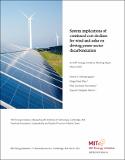System implications of continued cost declines for wind and solar on driving power sector decarbonization
Author(s)
Mallapragada, Dharik S.; Diaz Pilas, Diego; Gonzalez Fernandez, Pilar; Delgado Martín, Agustín
DownloadWorking paper: System implications of continued cost declines (3.314Mb)
Metadata
Show full item recordAbstract
Global efforts on confronting climate change through reducing energy-related greenhouse gas (GHG) emissions have seen the most success in the electric power sector through the continued growth in variable renewable energy (VRE) generation, as well as fuel switching from coal to natural gas (NG) in some regions. For example, between 2009 and 2018, global capacity installations of wind and solar increased by a factor of ~3 and ~20 respectively, enabled by continued technology cost declines and policy support1. In some regions, like the U.S., this trend has been complemented by the displacement of generation from coal with gas, leading to U.S. power sector CO2 emissions declining by 28% since 20052. Despite these promising trends, deep decarbonization of the power sector remains a daunting challenge, as reflected by the fact that VRE sources accounted for only 9% of global electricity generation in 2018, while generation from coal, the most carbon-intensive fossil fuel, accounted for 38% of total generation and continues to grow in some regions (e.g., India)3. Several studies project that global electricity consumption could grow by as much as 45-50%4 by 2050, driven by rapid growth of electricity use for services such as air-conditioning in currently under-served regions, electrification of other end uses like heat and transport, as well as increased digitization and associated proliferation of data centers to support cloud computing needs. This suggests that in order to ensure that power sector GHG emissions approach net-zero by mid-century, the rate of power sector decarbonization needs to be significantly accelerated. Given the long lifetimes of infrastructure investments in the power sector, the next 2-3 decades are likely to be pivotal in defining the longer-term GHG emission trends of the sector and the ability to achieve end-of-century climate stabilization goals.
The timely availability of low- or zero-carbon technologies that are also cost-competitive is a crucial lever for enabling the transition toward a more sustainable energy system. This document explores the potential for power sector decarbonization based on the cost-competitive addition of wind and solar technologies in the absence of any supporting policy, as per current technology cost and performance trends, as well as projected cost and performance in 2030. Additionally, the appendix provides an industry perspective5 on the potential technology roadmap and opportunity for cost reductions achievable for VRE generation and energy storage technology by 2030.
Date issued
2020-03Department
MIT Energy InitiativePublisher
MIT Energy Initiative
Keywords
energy, wind energy, solar energy, decarbonization